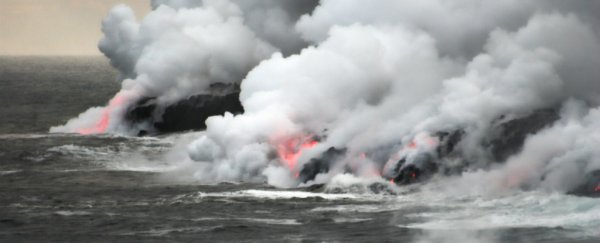When an underwater volcano erupts, completely altering the underwater landscape for kilometres, you'd assume it wouldn't be the best place to look for new life.
But researchers have discovered just that, identifying a new species of furry white bacteria covering a submerged volcano 130 metres (426 feet) below sea level in the Canary Islands.
Even weirder – it appears to have started colonising the volcano as soon as the temperature dropped.
"I bet there were microbes appearing there just as soon as those rocks got below 100 °C (212 °F)," says David Kirchman, from the University of Delaware, told Sam Wong at New Scientist.
Back in 2011, the Canary Islands were hit by a number of tremors, while under water the Tagoro Volcano completely blanketed the seafloor with new rock over 138 days.
Italian and Spanish researchers went to survey the area in 2014, expecting to see the underwater region still barren.
Instead, they discovered that the volcano was covered in white, hair-like microbes – a species the researchers hadn't seen before.
"It was an impressive and surreal landscape, like discovering life on Mars," Cinzia Corinaldesi, one of the researchers from the Polytechnic University of Marche told The Atlantic.
 CRG Marine Geosciences
CRG Marine Geosciences
The white hair, which they've called Venus's hair, was up to 3 centimetres (1 inch) long, and around 36-90 micrometres in diameter. (For reference, a human hair is between 17 and 180 micrometres in diameter.)
And this wasn't a small amount of fur - the researchers say it covered an area of roughly eight tennis courts (2,000 square metres, or about 21,500 square feet) across the volcano.
But none of that answers how the hell it got there in the first place.
"These organisms apparently come out of nowhere," Kirchman told New Scientist.
And not everything is as it appears, with countless passing microbes just waiting for an opportunity to settle and grow a family.
"It's helpful to remember that each drop of seawater contains millions of bacteria and that only one of them, in theory, is needed to colonise a new habitat, says Kirchman.
"The Venus's hair bacterium could have been in this 'rare biosphere' and by chance came across the virgin habitat created by the volcanic eruption."
Although the bacteria wouldn't grow in the lab, the team sequenced its DNA, discovering that Venus's hair was a completely new genus and species of the order Thiotrichales. The new scientific name for the hair is Thiolava veneris.
Venus's hair would have fed on the large amounts of hydrogen sulphide coming out of the rocks.
While they're only about 82 percent of the way through the DNA sequencing, the analysis does provide some hints on how Venus's hair survives - it has a gene that produces a protein 'pump' capable of removing heavy metals that leach from the new volcanic rock.
By the time the researchers had surveyed the area, the Venus's hair was already acting as a welcoming committee – worms and crustaceans had started making the hair their home, reigniting life in that barren location.
"A volcanic eruption is as devastating under the sea as it is on land, spewing out molten lava and toxic gas, destroying life in its shadow and disrupting habitats for kilometres in every direction," writes Kirchman in a Nature editorial accompanying the piece.
"But out of this destruction comes new land and the opportunity for life to begin again."
The research has been published in Nature Ecology & Evolution.
